February 2009 archives
you are here [x]: Scarlet Star Studios > the Scarlet Letters > February 2009
<< before
January 2009
after >>
March 2009
February 27, 2009
the humanity of monsters
by sven at 11:23 am
[Some email friends are currently discussing drama and monsters. I wrote this little essay in response. It seemed worth sharing with a larger audience.]
"How about creature movies based entirely on conflict of character?"
I think you're onto something.
When I think about the monster stories I like best, they're the ones where the monster is filled with humanity. John Gardner's Grendel: Beowulf told from the monster's point of view. H.P. Lovecraft's At the Mountains of Madness: the final realization is that the monsters are simply scientists clothed in non-human bodies -- and that they were themselves killed by something worse. Rachel Ingalls' Mrs. Caliban: a depressed housewife may or may not be having an affair with an 8-foot-tall frog man.
CATEGORY 1: HUMAN-SCALE MONSTERS
I think most of the successful monsters of the past 100 years have had humanity at their core. Werewolves, vampires, zombies, ghosts, Frankenstein's monster... A werewolf is a person with an explosive temper who transforms physically (much like the Incredible Hulk). A vampire is a person who seems charming, but drains you of your life. [Both vampires and werewolves seem to me to be cautionary tales for young women about men who are a bad husband material.] Zombies embody that feeling on Monday morning when you haven't had coffee yet: am I alive or am I dead? Ghosts are the frightening wish-fulfillment of having a dead loved one come back from beyond the grave. I haven't read it myself, but if I recall correctly, Frankenstein's monster ultimately confronts his creator and asks why he was created; man speaking to God.
CATEGORY 2: GIANT MONSTERS
Giant monster films tap into the same principles, but simply work on a larger scale. Rather than being the demons of interpersonal relationships or of one's own soul, they are metaphors for a society's demons. Godzilla being a metaphor for atomic energy is the classic example. King Kong, when you try to do a literary reading, is pretty obviously (in my opinion) an allegory about animalistic male libido being brought into conflict with civilization, and the needs of civilization (the city on the macro level, marriage on the micro level) having to win out.
AN ASIDE: SADISM & PACK ANIMALS
Granted, most giant monster films are just about the rampage, and due to this failing fall short of the best of the monster films. Cloverfield was Godzilla + Sept 11 + Blair Witch Project cinematography... Pretty, but lacking originality or depth. Similarly, in human-scale monster films, there hasn't been a lot that's new and interesting lately: a bevy of psycho-killer films such as Saw... The defining human trait of the monsters in these films is "sadism" -- but because the filmmakers focus on the inhumanity of the crimes rather than the humanity, there's less for us to emotionally latch onto. Remember, with a character like the wolfman, we feel some pity for the man who wants to control his animal side but is unable to. Frankenstein's monster: pity. Kong: pity.
[There's also a hive-mind version of the sadistic psycho-killer... Monsters that act like a pack of wild dogs. Think of the zombies in I Am Legend. Sure, we had a slightly new origin story -- but all you can really say about the essence of the monsters is that they're mean and they don't stop when you protest. Sadism again. Just transposed onto pack animals.]
CATEGORY 3: HOSTILE ENVIRONMENT
So, human-scale monsters and giant monsters are two important categories to consider, dramatically-speaking. One more to to look at is monsters as an expression of a hostile environment. Dinosaur films tend to be like this. In King Kong and Planet of the Dinosaurs and the like, the dinosaur-monsters don't tend to have a lot of individual personality -- because the point is just that the place where our explorers have landed is itself a monster. Films like this function much like disaster films do. Think about The Poseidon Adventure or The Towering Inferno. We put a large cast through a series of minor deadly incidents and see who comes out the other side. Same thing when we first arrive on Skull Island.
A CLOSER LOOK AT KONG
Kong in some ways is two movies. A disaster film when we're on Skull Island... Who among the explorers will get out alive? And then when we get to the city, a sort of magic realist expression of Libido vs. Civilization. ...Yet, that's if we focus on Jack Driscoll and Ann Darrow as the film's protagonists. An argument could be made that while they are our POV characters, it's actually Kong himself who's the main character of the story...
Peter Jackson amped up this angle a bit by having Ann do cartwheels for Kong on Skull island, and then go sliding on the ice skating pond in New York... But it's there in the original version too... When Kong has Ann in his cave, just before a snake goes after her, Kong is picking a flower to give to her. See, Kong is like the traditional "caveman" male who is valuable when his job is to simply to protect (and possess) his mate -- but this form of brute manhood can no longer be permissible in modern society. Kong is a tragic figure because he can't keep up with the times.
So anyway... Yeah, I think monsters almost always work best when you can find their core of humanity and operate from that. And the enduring monsters always have some sort of metaphorical value, where they embody a demon of the human spirit.
THE DIFFERENCE BETWEEN SUPERHEROES AND MONSTERS?
It's probably also worth pointing out that most monsters have a sort of wish-fulfillment value, too. Wouldn't it be neat to be ten stories tall for a little while? Or if when you were angry, your entire body could transform to truly reflect how you're feeling? There's a commonality here with superheroes. I mentioned the Incredible Hulk earlier. How is he really different from a werewolf? Superman, Invisible Girl, the Human Torch... These sorts of powers are fairly primal in terms of wish-fulfillment... So I guess I'll end this little foray with a rhetorical question: What makes a monster different from a Super Villain?
A Super Villain, the antithesis of a Super Hero, has to have some sort of special power... And so does a creature from a monster film. Is the only difference that monsters are clothed in animal bodies rather than human bodies? Are the classic vampire, werewolf, zombie, creature-from-the-black-lagoon type monsters a sort of half-way point: villains that are half-human, half-animal? [Vampire=bat-man, werewolf=wolf-man, zombie=dead/alive man, creature=fish-man...]
When you get down to it, if you're willing to look at monsters as human souls that merely have (a) an unusual appearance, and (b) a super power of some sort, then what we've arrived at is the cast of the Uncanny X-Men. Whether we're dealing with a heroic mutant or a villainous monster is simply a matter of how the character chooses to act, based on what their personal needs and desires are...
Which brings us full circle back to your original idea: "How about creature movies based entirely on conflict of character?"
posted by sven | permalink | categories: writing
February 26, 2009
birthday card: linnea bell
by sven at 7:00 am
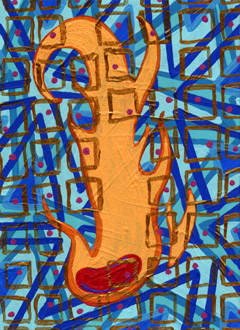
Today is Linnea's birthday...
From Sven & Gretchin: happy birthday Linnea!
posted by sven | permalink | categories: painting
February 25, 2009
birthday card: jeffrey roche
by sven at 7:00 am
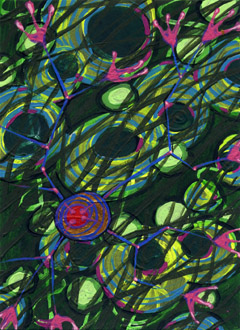
Today is Jeffrey's birthday...
From Scarlet Star Studios: happy birthday Jeffrey!
Deep down in the murk of the old bayou, where Jenny Greenteeth lurks, there is a golden eye watching. A lightning bolt spider web of nerve-thin legs anchor it to the billowing weeds... And to the witch. Thirty-two soft pink hands grip onto Jenny's hair while she sleeps fitfully -- her own lidless eye restlessly twisting in its socket.
What is this horror? And look, there on one of its many tiny fingers... A wedding ring?
posted by sven | permalink | categories: painting
February 11, 2009
learning ceramics with sara swink
by sven at 7:00 am
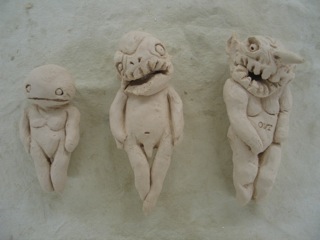
On Jan 17 & 18 I took a class from local ceramic sculptor Sara Swink titled "Two-Day Creative Process Workshop." Highly recommended!
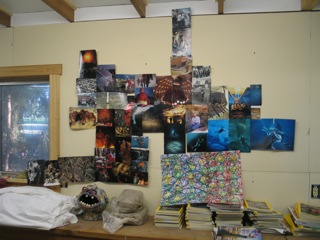
Most of our time on the first day of the workshop was devoted to doing intuitive collages. Being familiar with the exercise, wherein you collect images without trying to figure out why they appeal to you, I decided to try a bold new experiment: collaging outward without boundaries.
I'm pleased with the end result... But not quite sure what to do with it now. Sara demonstrated cutting your collage into pieces and making a book with them. I can't quite bring myself to dismember the thing yet.
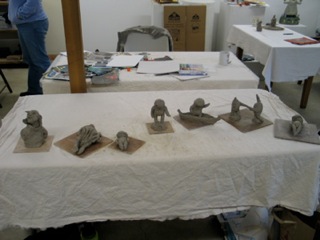
The point of collaging is to begin developing a "personal vocabulary" of images. On day two, we started with doodling exercises -- then moved into sculpting ideas from our collages in clay.
At first I was frustrated, because I didn't feel emotionally connected to what I was making. Two thoughts helped: (1) the idea that I could "doodle in clay" rather than trying to translate inherently 2D concepts to 3D; and (2) remembering that cel animators think about their characters in terms of underlying volumes, not just outlines.
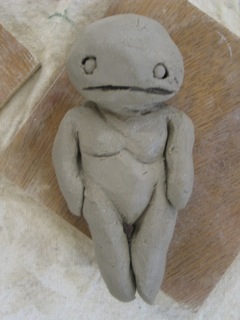
Here's the first character I made that I felt happy with. "Babi" (pronounced "baby") is a reference to a drawing I did way back in high school. I'm not sure how to explain what "babis" are... They're generally blobby child-proportioned critters that live in the realm of dreams and the subconscious, hopping from one person's mind to another without anyone being aware.
The "babi" series that's emerged is very pleasing -- I'd like to see these characters turned into stopmo puppets.
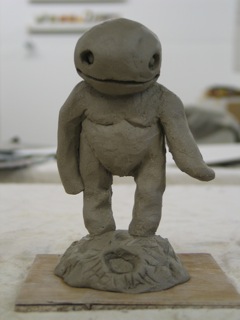
I was attracted to the "creative process" class for a number of reasons...
I've never done much with water-based clay, and wanted to add ceramics to my skill set. Learning about clay with a sculptor rather than a potter seemed like the way to go.
I'm looking at clay as the sculptor's pencil: the fastest, cheapest way to rough out 3D ideas. I want use this medium for stopmo character development. Drawn sketches are useful, but not as illuminating as maquettes; Super Sculpey maquettes are too expensive to make en masse.
Also, as an artist, I'm very interested in process. This class, with its focus on developing one's "personal vocabulary" of images particularly excited me, because I feel like my analytical tendencies sometimes undermine connection to the content I'm developing.
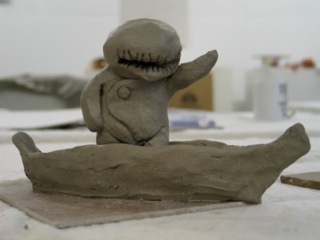
Since the weekend class, I've gone back to Sara's studio for two more work sessions. My original seven sculptures -- plus an additional one from the following weekend -- have now been bisque fired. (That's the initial firing you do to make the clay hard and strong... Glazes are added in a second pass.)
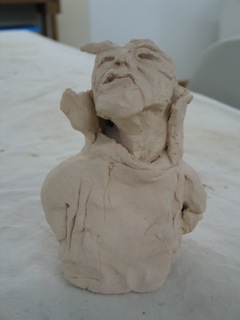
For the sake of getting the full ceramics experience, I'm going to go ahead and glaze most of the pieces. This bust I made, however, is going to be painted with acrylics. If I wind up bisque firing clay character sketches in the future, I imagine I'll opt to just paint them, rather than glazing.
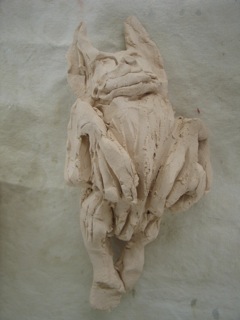
The bust was the very first piece I made, and I don't like it much. My second piece was this bat, which I like a good deal more -- but it still didn't really feel like "me" when it came out. It's going to be a wall-hanging with a black-brown glaze.
(Every time I look at the bat, it makes me think of Shu-Ju Wang -- a local book arts friend who's very into our nocturnal, flying companions.)
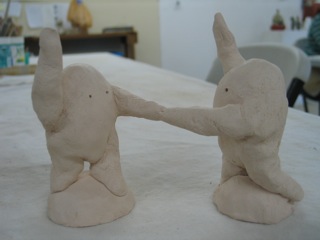
Sara has ongoing drop-in classes on Saturdays, where you get individualized attention and can work at your own pace. For a while, it looked like I'd be going directly from my Saturday morning playwriting classes over to Sara's studio....
Unfortunately, I'm feeling very pinched for time now, so ceramics work is going to have to be sporadic for a while. Even so, I'm really glad that I grabbed the opportunity to take the process class when I had it. Very inspiring -- I strongly recommend taking it if you have the opportunity.
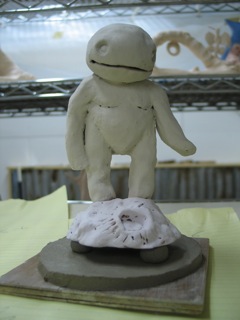
posted by sven | permalink | categories: classes & workshops, sculpture
February 10, 2009
coraline's technical innovations in historical context
by sven at 7:00 am
In my opinion, three major technical innovations in the art of stopmo have made Coraline possible: digital cameras/framegrabbers, CNC machining, and the 3D printer.
These relatively new tools are being used to try to solve stopmo's biggest challenge: how do we create puppets with expressive faces?
Whoever comes up with the best answer, leads the art form forward. There is no perfect solution yet -- but I think that Coraline presents the most plausible solution to date.
From King Kong to Jack Skellington
The influence of King Kong (1933) cannot be overestimated. The work of Willis O'Brien lead to the era of grand master Harryhausen, which led to the "hyper-Harryhausen" innovations of Phil Tippett... Three generations of "Dynamation," using stopmo to put photorealistic monsters onscreen with live action.
That lineage effectively came to an end with the release of Jurassic Park in 1993. Hollywood was overzealous in adopting CG monsters; Dynamation almost died out. Stopmo technology has now advanced to a point where a maverick director could make excellent non-ironic use of puppets in a feature monster film. Yet, there are big advantages to doing effects films in an all-digital environment, and one of stopmo's weaknesses is doing swarms of monsters... So it's implausible that the golden age of stopmo monsters (if one ever existed) will return.
However, 1993 was also the year that The Nightmare Before Christmas came out. Technically, it has roots that go back to folks like George Pal and Rankin & Bass -- yet, it was truly a seminal film. Rather than going for photorealism, TNBC embodies visually stylized storytelling. The aesthetic is one of translating 2D illustrations into 3D media.
Along with this new aesthetic has come new technical challenges to conquer. We know a lot about how greenscreen monsters into a live action context (for example) -- but do we know enough about how to make humanoid puppets that can give a full range of emotional expression?
Technical innovations in stopmo since 1993
Corpse Bride and Coraline have both been attempts to build upon and best the innovations of TNBC. Technically, TNBC had puppets with astonishingly tiny joints and it made remarkable use of replacement heads. Corpse Bride was able to take the art further by making use of digital cameras, framegrabbers, and clockwork head technology. Coraline further innovates by using stereoscopic photography, faces produced on a rapid prototyping 3D printer, and armature joints smaller than anything I've ever seen.
What do these innovations mean?
Well, framegrabbers and digital cameras have revolutionized stopmo as a whole. Our ability to create subtle movements, check our work, and delete a frame if a mistake was made... Well, that's huge.
Stereoscopic photography, though? It was beautifully accomplished in Coraline, no question -- but I'm going to feel this technology is a gimmick until there's even the slightest chance that it could become the default for live action filmmakers. I just don't see that ever happening.
Tiny joints are also here to stay, I believe. I can't confirm this, but I think that CNC machining has come a long way since TNBC came out. From photos, it appears to me that armature makers then had to make the majority of their joints one at a time. Now, the standard practice is to outsource making joints to a small parts manufacturing company. Having large supplies of generic joints on hand changes the armaturist's job. It's only on a very special character -- like Oogie Boogie, for instance -- that you're going to see things like universal joints, collet joints, etc. Armaturing now is, for the most part, more about assembly than design.
The big challenge: expressive faces
Where the real "arms race" lies, I believe, is in the technology required to make expressive faces. It's very difficult to do, and I don't think the perfect solution has been found yet.
Corpse Bride's clockwork heads were astonishing... But also profoundly complicated -- far out of the reach of any indy filmmaker. (Though Ron Cole's cable puppets offer a plausible alternative.)
By contrast, creating heads like those in Coraline is not overly complex. There are two main strategies: paddles attached to tiny step-block joints inside the puppet's skull, or resin faces that snap into place with magnets.
Paddles are somewhat prohibitive due to the difficulty of making tiny joints, which are more easily accomplished on a CNC machine. Snap-on faces are most easily created using a 3D printer, but could still be done on a small scale by resculpting a set of identical clay heads and making multiple resin castings. If you had the right tools, neither strategy would be too difficult; yet even without CNC and 3D printing, you can hobble along making things by hand. The only thing that's really out of reach for the solo animator is making thousands of snap-on facial expressions -- and that's really just a function of time/money.
[In an odd way, I find this all very heartening. It was depressing that I couldn't even understand how the Corpse Bride heads worked. As an artist, I felt defeated by the "experts" in my field. With the Coraline puppets, though, I've been excited to realize that I understand what I'm looking at. And I could imagine how one might use this set of strategies to solve specific puppetmaking problems. It's encouraging to think that I could maybe hold my own alongside other puppet fabricators, were I to ever land a job at someplace like Laika.]
Which technology will win out?
I think the Corpse Bride clockwork head technology will be abandoned because it's overly complex. There will only ever be a tiny number of people who understand how to make those heads. It won't be passed on to the next generation... And research and development costs at the outset of a film would always remain high.
Snap-on faces and paddles, on the other hand, are not that complicated if you have access to CNC and 3D printers. It seems likely to me that this technology will catch on and become the future of puppet faces in stopmo feature films.
Yet, snap-on faces are not a perfect solution to the problem. In contrast to paddles, you get exquisite control -- freedom to work out the faces in advance, so that "acting on the head" becomes as mechanical for the animator as following an X sheet for lipsync. But what about those seams between the forehead and the lower face? The folks working on Coraline did a great job of digitally erasing them (in 3D no less!) -- but what a hassle! In some shots you can see that they just decided to leave the seams in (notably on Bobinski).
So, there you have it... Coraline represents the state of the art -- but our art form still has a significant technical problem to resolve: how to best make expressive puppet faces?
ADDENDUM:
Maybe use of 3D printers isn't beyond solo filmmakers after all! I just remembered a link that Shelley Noble sent a few months back, about an online service that does 3D printing called shapeways.com. You send them the file, they send you a 3D plastic object. Price? $2.89 per cubic centimeter of material.
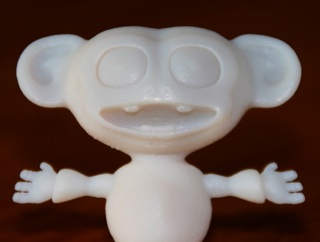
posted by sven | permalink | categories: stopmo
February 8, 2009
coraline puppet technology - with photos!
by sven at 4:43 pm
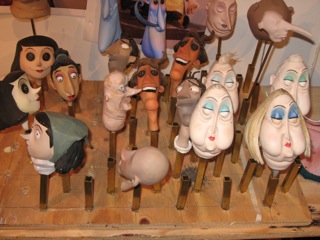
Thursday night I went to the world premiere of Coraline. There's lots to say about the film itself... What has my mind buzzing, though, is the party at the Portland Art Museum that came afterwards.
To convey to party attendees how much effort went into fabricating Coraline's world, Laika/Focus set up stations around the room where people from different parts of the art department had their actual workbenches and stuff they'd created: hair, painting, armatures, knitting, sewing. Amazingly, we were allowed to ask whatever questions we liked and take photos. ...So you better believe I did!
As an indie stopmo filmmaker, I have a powerful interest in puppet construction. So I'm going to share what I was able to learn or deduce. Click on the photos for larger images.
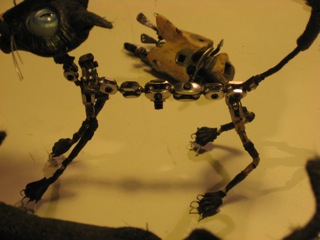
I think that the world of Coraline was produced at 1:8 scale. That means a 6' tall person would be reproduced as a 9" tall puppet. I estimate that Coraline was 7" tall. Stunt puppets at different scales existed for special purposes -- such as the close-up of the sewing needle during the opening credits. I was told that the doll was scaled up more than 2000% for that shot.
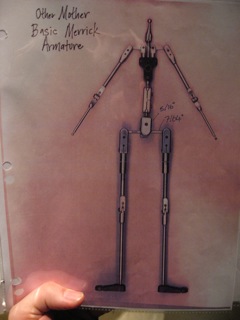
The armatures, were tinier than any I've ever seen. Tie-downs used 4-40 screws -- and that was the largest screw size I saw on any of the armature maps. I recall seeing frequent use of screws labeled 2-56, 1-72 (?) and 0-80. Due to a certain logic inherent in producing step-block joints, it's likely that joints using 4-40 screws also used 1/4" balls. Stainless steel balls are only sold in certain increments: 4/16", 3/16", 2/16", 1/16"... I feel fairly confident that the 0-80 screws were being used in joints that had 1/16" balls and 1/32" rods.
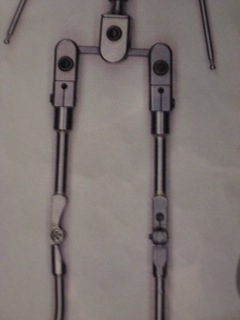
Merrick Cheney down in San Francisco made many of the lead character's armatures. However, it was not uncommon to discover when they arrived in Portland that they would require some retrofitting to fit inside the molds. Most of the armaturists' labor, it sounds like, was a matter of assembling and modifying generic joints. Joints were not being made on premises; the job was outsourced to companies that specialize in small parts manufacturing. Cheney's company produced most of the joints, but there was also another company involved ("Columbia?"). Use of rototools was specifically mentioned with regards to modifying joints for greater range of motion.
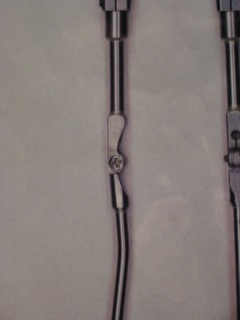
Almost exclusively, the only types of joints I saw being used were step-blocks and double-ball sandwich joints. I did see hinges being used for elbows and knees on some puppets, as well as hinge and swivel assemblies for shoulders occasionally. Sometimes the toe of the foot had a hinge. I saw a surprising variety of ankle configurations, which I'd have liked to study further. I had the sense that some of the chest blocks, with built-in neck and spine balls and hinge/swivel shoulders had been created prior to work beginning on Coraline -- stuff that Cheney had on hand.
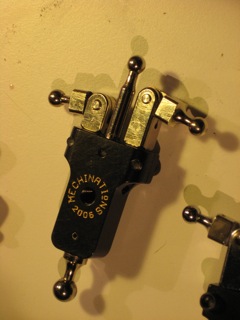
For 1/16" balls, using the usual jeweler's torch would have fried them -- so a butane microtorch was used instead. A special jig was made to hold rod in place, while another tool would hold the ball on top from shooting off. If a ball popped off while brazing, you'd never find it again.
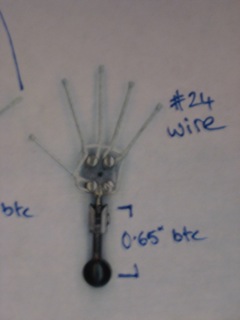
Safety Silv soldering wire was used (not Stay-Brite or jeweler's "hard" silver solder); the person I spoke to didn't recall which grade. For shining armatures, pickle was used. Someone from the rigging department said that after pickling he'd use a brass wire brush, which wouldn't scratch the stainless steel balls. I'm not sure if this was also common practice among the armature makers.
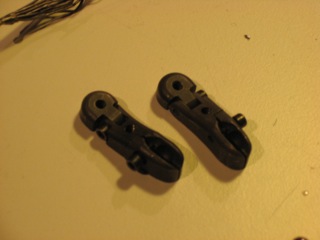
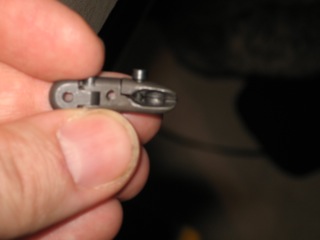
In general, the armature designs I was seeing didn't offer any big surprises. It appears that a standard design has evolved, which is very much like the example that Lionel Ivan Orozco shares in his Armature Anatomy 101 tutorial.
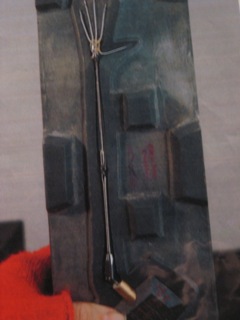
The really fascinating stuff had to do with how the heads were constructed. I saw two basic types of technology.
One strategy involved creating a hollow resin skull with areas carved away where there would be facial movement (mouth and eyebrows, generally). In these hollow areas, there were little metal paddles attached to tiny step-block joints. There might be one or two paddles for each eyebrow, and then maybe three paddles for the upper lip. The actual face was a silicone sheath that would somehow fit over this skull. The Father and Other Father puppets used this technology.
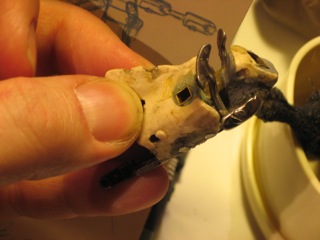
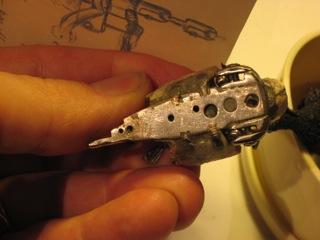
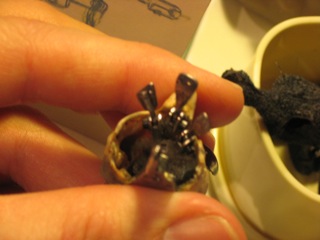
The other strategy was snap-on faces. Faces were divided into two parts: the forehead, and the rest of the face below the corners of the eyes and bridge of the nose. Seams were removed digitally in post-production using Shake (a software similar to AfterEffects). How they managed to do this and maintain the stereoscopic effect, I have no idea.
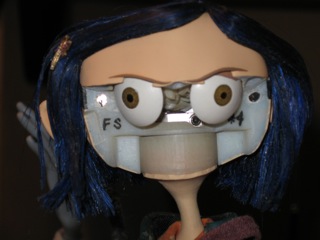
I was boggled at how such precision little parts might have been cast from molds... Until I realized (with some certainty) that these pieces all must have been created using rapid prototyping 3D printer technology. The face shapes, then, were surely created using CG modeling software of some sort. ...Whether or not an original physical sculpt was inputted using a 3D scanner is unknown.
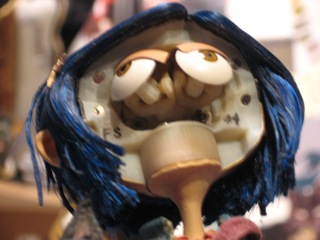
There was astonishingly widespread use of magnets for holding different parts of the puppets together. I'd say the magnets were 1/16" diameter neodynium. Each piece of the face might be attached using several magnets. I wondered if the orientation of the magnets mattered, since magnets can repel as well as attract -- but didn't think to ask. Puppets like Coraline and Wybie used the hair and chin lines to their advantage; Bobinski and the cat were different, making use of smile lines to hide seams.
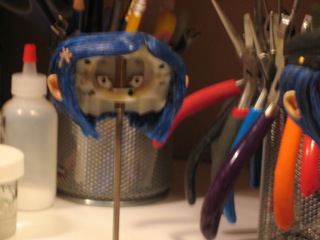
Coraline's eyes were flattened hemispheres that were attached to the skull behind the two-part snap-on face. I was very surprised to see that they were attached using resin joints rather than metal ones. I'm still having trouble figuring out what I saw, but it seemed that the ball-capture plates were attached to the back of the eye, and a ball was attached to the skull. I think the eyes may have actually used plastic universal joints -- but as I said, I'm still confused. Eyelids could rise and lower and had their own separate joint mechanisms in the skull, squashed in with those for the eyes.
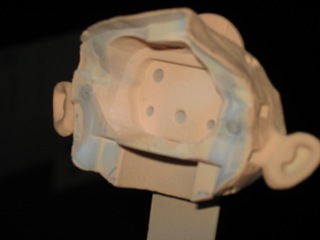
Some characters appeared to have K&S plug-ins for eyes. I didn't see any collections of eyes with square-shaped plugs on their backs, so I'm somewhat confused by this. Eyes in general didn't have holes in the retina (as is common for puppets)... So when the animators used sharp things to move them, the eyes were frequently damaged, irritating the folks in charge of fabrication and repair.
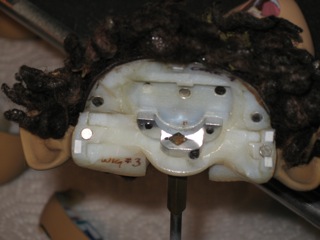
The heads generally had squat cylinder-shaped cavities at the base where the neck connection could be concealed. The neck-to-skull connection generally involved square telescoping K&S... But rather than being cast or glued into the skull, I saw steel bits at the base of the skull that allowed you to capture the K&S with a screw.
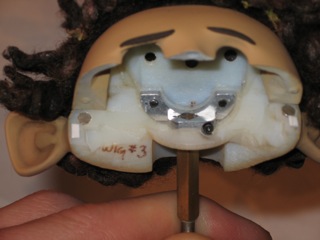
With the exception of the Other Mother (a special case), I didn't see any jointed hands. Hands were made from thread-wrapped floral wire. I saw one hand design that had a wrist ball attached to a flat palm, which had four screws for capturing the wire fingers, all made from one piece of wire. A threaded tie-down hole was also placed in the palm.
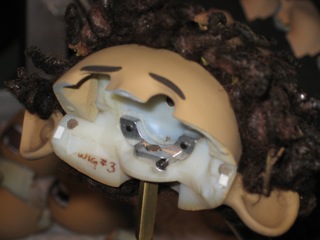
It was impressed upon on me that rigging points in general should never be round -- they should always use telescoping square K&S to prevent the puppet from accidentally rotating around -- as might happen, were you to only use a threaded rod.
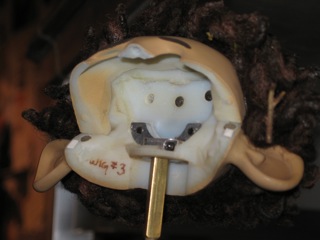
Wigs were made from synthetic hair and sometimes mohair. Natural fibers were too subject to expanding and contracting with changes in temperature. All the fibers were hand-dyed. They'd be held together using massive amounts of a hair-styling fluid with the consistency of water, painted on with a brush. It sounded like the wires in the hair were usually thread-wrapped floral wire. Lay down the wire, then lay down the hair on top of it. Pony tails and other large hair sometimes had ball joints hidden inside, for the sake of being animatable. Thus, the hair department sometimes had to collaborate with the armature department.
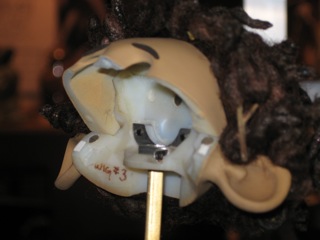
For certain puppets, aluminum wire was cast inside the silicone skin. This was the case with the scotty dogs and with the melting Other Father's mouth. With the Other Father, The wires didn't form an "O" as one might expect -- they were perpendicular to that.
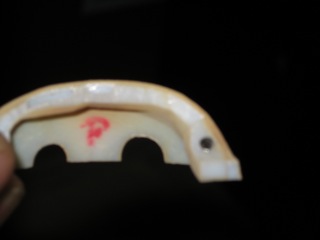
Both silicone and foam latex were used for puppets. (A bit of a surprise: I recall reading an interview back when "Life Aquatic" came out saying that Selick was never going to use foam again.) Coraline's dad had a silicone head. Forcible and Spink had foam latex bodies... Presumably because such bulky puppets would have been too heavy otherwise.
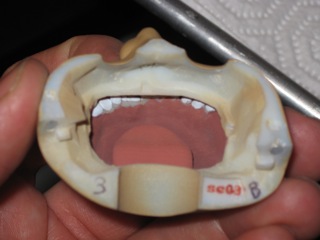
The folks on this project worked 50 hour weeks during the entire course of the production. One person I spoke to said that this might not be the case if Laika does future feature films. This person thought Laika had learned its lesson: You can work at that pace for a month or two -- but after two years, people were simply too exhausted. It cut down on productivity to the point where 40-hour work weeks may have been just as effective.
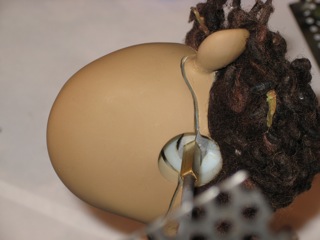
posted by sven | permalink | categories: stopmo
February 5, 2009
the cauldron of fiction
by sven at 2:51 am
I'm studying how to create fiction. Here are three metaphors I'm finding useful –– each of which has to do with water.
the stream of consciousness
There is the conscious mind, and then there is the unconscious mind. The conscious mind can attempt to work things out by logic... But the true source of thought is the unconscious.
I mean this literally: try putting earplugs in your ears. Curiously, even in a silent room there's a lot of background noise. Remove that, and it's astonishing how much easier it is to hear that little voice inside your mind talking to you.
That little voice, with its never-ending commentary -- it originates from the subconscious. In some ways, the voice is that which is most you. And yet, there is still another part of the mind which can simply sit and listen to the voice, observing it. This is a precept of meditation. It is also a precept of stream-of-consciousness writing, where you sit and simply transcribe what the voice says as you listen to it.
The stream-of-consciousness is the source of energy that will power all your creative endeavors. Learn to tap into it with intention.
the pitcher of thought
I've heard it said that the mind can only hold seven thoughts at a time. Whether or not the number is accurate, it matches my experience that I can only consider a limited number of things simultaneously.
In a very literal way, if I can remove one thing from my mind, I make room for something else. I don't worry about failing to get more ideas -- the stream of consciousness will provide. I imagine this like a magic pitcher of water: as quickly as I can pour water out of the pitcher, it will be replaced with more water.
This line of reasoning leads me to proclaim: do not think inside your head! When I try to figure things out just by thinking, it's generally a slow process of transformation. But when I write, I remove thoughts from my brain and see new ones take their place just as fast as I can move my writing hand across a page of paper.
the cauldron of fiction
notebook as cauldron
Fiction is created through the process of listening to your stream-of-consciousness and writing it down on paper as fast as you can. You're allowed to think in ways that are imaginative or in ways that are analytical. You're allowed to keep your mind narrowly on task or to digress for the sake of getting unrelated distractions out of your head. What really matters is that you engage in this physical act of putting words down on the page as quickly as you can.
Whatever notebook or digital document I apply this process within, I liken it to my "cauldron of fiction."
stirring
In my opinion, the essence of thought is questions. In the leap from one thought to another thought, I believe there is always a bridge: a question that popped into your mind. The majority of the time, questions occur to us and are answered so quickly that we don't even notice they happened. Speed makes them invisible. But if you make an exercise of generating questions, you will be astounded at how quickly your thoughts begin progressing to new conclusions.
I like to think of this conscious application of questions as "stirring the cauldron."
ingredients
Before you can cook something in the cauldron, you have to fill it with raw materials. Creativity is not a matter of pulling ideas out of thin air -- it's about taking raw materials and transforming them. Reading plays, watching movies, looking at paintings, doing research, collecting reference photos... These sorts of activities are what some theories of creativity call the "gathering" phase... Or what Julia Cameron calls "filling the well"...
Or what I might call "filling the cauldron with ingredients."
enriching the broth
When you generate fiction, it's useful to remember what Buzz McLaughlin calls "the iceberg principle": only 5% of the world you create will actually appear onstage or in your novel. Through the writing-as-fast-as-you-can and asking-lots-of-questions method, your imagination will begin to develop a rich story world upon which to draw. Oh, you can start ladling out soup as soon as you want... But it's going to be watery fare if you haven't spent a fair amount of time cooking.
Thicken the stock; thicken your plot.
serving portions
There is a difference between the mythology of a story and the text of a story (to borrow terms from Orson Scott Card). The "mythology" is everything that has ever happened in your story universe: the long line of cause and effect, the interrelated histories of individuals, places, and things. The "text," on the other hand, is merely that which the audience gets to see... A brief window of time, a limited number of events, constrained by the POV of the characters.
The soup that you're constantly developing in the cauldron of your notebooks is the mythology of your story world. As wild explorations coalesce into concepts that feel fairly settled-upon, extract these discoveries from the soup and save them as auxiliary documents. Either summarize or cut'n'paste the reference materials directly from your generative cauldron...
"Auxiliary documents" are what you serve up.
the cauldron vs. the bowl
Ultimately, your final salable fiction is merely another auxiliary document! Yes, you'll put extra time and effort into polishing it up... But really it's the mythology in the cauldron -- the 95% of the iceberg -- which is the real story. What you share with the world is merely a fragment of that living broth.
The cauldron is more valuable than the bowl.